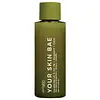Avoskin Your Skin Bae Ceramide LC S-20 1% + Mugwort + Cica Toner Versus Round Lab Mugwort Calming Toner
What's inside
What's inside
 Key Ingredients
Key Ingredients

 Benefits
Benefits

 Concerns
Concerns

No concerns
 Ingredients Side-by-side
Ingredients Side-by-side

Water
Skin ConditioningPropylene Glycol
HumectantGlycerin
HumectantCentella Asiatica Extract
CleansingPhenoxyethanol
PreservativeButylene Glycol
HumectantHydroxypropyl Bisstearamide Mea
Skin ConditioningPolyglutamic Acid
Skin ConditioningChlorphenesin
AntimicrobialBehenyl Alcohol
EmollientDipropylene Glycol
HumectantTetrasodium EDTA
Ascorbic Acid
AntioxidantCeteareth-20
CleansingCholesteryl Isostearate
EmollientTricaprylin
MaskingCetearyl Alcohol
Emollient1,2-Hexanediol
Skin ConditioningCholesterol
EmollientSqualane
EmollientArtemisia Princeps Leaf Extract
Skin ConditioningStearic Acid
CleansingDimethicone
EmollientSodium Hydroxide
BufferingWater, Propylene Glycol, Glycerin, Centella Asiatica Extract, Phenoxyethanol, Butylene Glycol, Hydroxypropyl Bisstearamide Mea, Polyglutamic Acid, Chlorphenesin, Behenyl Alcohol, Dipropylene Glycol, Tetrasodium EDTA, Ascorbic Acid, Ceteareth-20, Cholesteryl Isostearate, Tricaprylin, Cetearyl Alcohol, 1,2-Hexanediol, Cholesterol, Squalane, Artemisia Princeps Leaf Extract, Stearic Acid, Dimethicone, Sodium Hydroxide
Water
Skin ConditioningDipropylene Glycol
HumectantGlycerin
Humectant1,2-Hexanediol
Skin ConditioningGlycereth-26
HumectantArtemisia Vulgaris Extract
Skin ConditioningChondrus Crispus Extract
Skin ConditioningSaccharum Officinarum Extract
MoisturisingXylitol
HumectantArtemisia Princeps Leaf Extract
Skin ConditioningChlorella Vulgaris Extract
Skin ConditioningCamellia Sinensis Leaf Extract
AntimicrobialSalvia Officinalis Oil
MaskingTheobroma Cacao Seed Extract
AntioxidantPentylene Glycol
Skin ConditioningBetaine
HumectantPanthenol
Skin ConditioningPropanediol
SolventPolyglyceryl-10 Laurate
Skin ConditioningEthylhexylglycerin
Skin ConditioningAllantoin
Skin ConditioningDipotassium Glycyrrhizate
HumectantGlucose
HumectantButylene Glycol
HumectantFructooligosaccharides
HumectantFructose
HumectantBiosaccharide Gum-1
HumectantDextrin
AbsorbentMadecassoside
AntioxidantTocopherol
AntioxidantCarbomer
Emulsion StabilisingXanthan Gum
EmulsifyingWater, Dipropylene Glycol, Glycerin, 1,2-Hexanediol, Glycereth-26, Artemisia Vulgaris Extract, Chondrus Crispus Extract, Saccharum Officinarum Extract, Xylitol, Artemisia Princeps Leaf Extract, Chlorella Vulgaris Extract, Camellia Sinensis Leaf Extract, Salvia Officinalis Oil, Theobroma Cacao Seed Extract, Pentylene Glycol, Betaine, Panthenol, Propanediol, Polyglyceryl-10 Laurate, Ethylhexylglycerin, Allantoin, Dipotassium Glycyrrhizate, Glucose, Butylene Glycol, Fructooligosaccharides, Fructose, Biosaccharide Gum-1, Dextrin, Madecassoside, Tocopherol, Carbomer, Xanthan Gum
 Reviews
Reviews

Ingredients Explained
These ingredients are found in both products.
Ingredients higher up in an ingredient list are typically present in a larger amount.
1,2-Hexanediol is a synthetic liquid and another multi-functional powerhouse.
It is a:
- Humectant, drawing moisture into the skin
- Emollient, helping to soften skin
- Solvent, dispersing and stabilizing formulas
- Preservative booster, enhancing the antimicrobial activity of other preservatives
This leaf extract comes from the Asian mugwort. It has antioxidant and anti-inflammatory properties.
Fun fact: This flower is part of the sunflower family.
Butylene Glycol (or BG) is used within cosmetic products for a few different reasons:
Overall, Butylene Glycol is a safe and well-rounded ingredient that works well with other ingredients.
Though this ingredient works well with most skin types, some people with sensitive skin may experience a reaction such as allergic rashes, closed comedones, or itchiness.
Learn more about Butylene GlycolDipropylene Glycol is a synthetically created humectant, stabilizer, and solvent.
This ingredient helps:
Dipropylene glycol is technically an alcohol, but it belongs to the glycol family (often considered part of the ‘good’ alcohols). This means it is hydrating and gentle on skin unlike drying solvent alcohols like denatured alcohol.
As a masking agent, Dipropylene Glycol can be used to cover the smell of other ingredients. However, it does not have a scent.
Studies show Dipropylene Glycol is considered safe to use in skincare.
Learn more about Dipropylene GlycolGlycerin is already naturally found in your skin. It helps moisturize and protect your skin.
A study from 2016 found glycerin to be more effective as a humectant than AHAs and hyaluronic acid.
As a humectant, it helps the skin stay hydrated by pulling moisture to your skin. The low molecular weight of glycerin allows it to pull moisture into the deeper layers of your skin.
Hydrated skin improves your skin barrier; Your skin barrier helps protect against irritants and bacteria.
Glycerin has also been found to have antimicrobial and antiviral properties. Due to these properties, glycerin is often used in wound and burn treatments.
In cosmetics, glycerin is usually derived from plants such as soybean or palm. However, it can also be sourced from animals, such as tallow or animal fat.
This ingredient is organic, colorless, odorless, and non-toxic.
Glycerin is the name for this ingredient in American English. British English uses Glycerol/Glycerine.
Learn more about GlycerinWater. It's the most common cosmetic ingredient of all. You'll usually see it at the top of ingredient lists, meaning that it makes up the largest part of the product.
So why is it so popular? Water most often acts as a solvent - this means that it helps dissolve other ingredients into the formulation.
You'll also recognize water as that liquid we all need to stay alive. If you see this, drink a glass of water. Stay hydrated!
Learn more about Water